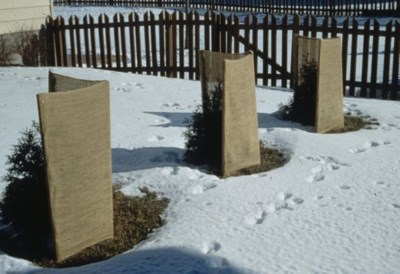I know gardeners don't want to hear the 'W' word, but considering the Farmer's Almanac prediction for a tough winter, it's time to do some planning!
Although wrapping and covering should wait until we get consistently cold weather in late October or early November, you should gather supplies now so you are prepared when the weather turns.
If you have broadleaf evergreens such as rhododendrons, holly, euonymus and boxwood, they need a good blanket of snow to insulate foliage for the winter.
Low-lying varieties usually do well in our area, but growth that sticks up above the snow can be harmed by cold winter temperatures. You can prepare now to help prevent this damage.
 Burlap screen
Burlap screenIt is a white, felt synthetic blanket that can be re-used year after year. Unwrap on an overcast day next spring and then simply rinse Arbortex off, hang it to dry and fold it up for storage. You can also keep it on hand for covering tender plants from spring frost.
Most evergreens won't need to be wrapped if you have chosen hardy varieties, but Dwarf Alberta Spruce tends to easily burn above the snow line. A wrap of Arbortex will help prevent this problem.
Upright juniper and cedar are prone to splaying open when we get loads of heavy, wet snow. Use an open mesh called Winter Wrap, for pulling foliage in tightly. It will prevent this type of winter damage.
There is also a green shrub-guard available that is more rigid plus perforated to allow for good air flow. Use this product if you have an evergreen in a spot that may get a very heavy snow load.
If you have a problem with deciduous shrubs having similar damage in winter, you can always use twine to pull the branches together. Once the branches are well secured, they will help support each other.
If you like to use a wooden teepee to cover evergreens, you have to use one large enough to allow for a six inch space between the wood and foliage.
Foliage that touches the wood will freeze and thaw numerous times over the winter as sun warms the wood and condensation forms on the inside. Be sure to increase the size of the teepee as evergreens grow.
If you have a hedge that is exposed to cold north winds or salt spray from a major roadway, set up a burlap or Arbortex screen. Pound tall stakes into the ground about a foot in front of the hedge. Staple protective fabric to the windward side of the stakes to create a barrier.
Tender roses, such as Hybrid Teas, Grandiflora and Floribunda varieties, need protection from northern winters. In late fall, place a rose collar around the plant, secure it in place and fill it full of compost or soil.
The soil will freeze solid and stay frozen until spring. (It is the repeated freezing and thawing that kills tender roses.) Hardy shrub roses don't require winter protection.
If you have a hybrid climbing rose, cover as high on the canes as you can and prune away the remaining length. Exposed canes will die over the winter.
White spiral tree guards should be put around the trunks of tender young trees to prevent rodents from chewing tasty bark in winter. However, don't leave the tree guard on over the growing season! It provides a perfect haven for insects to hide.
If you have a young tree that may get frost cracks, wrap the trunk from the ground up to the first set of branches with Tree Wrap or strips of Arbortex. Many maples are prone to this injury. In early spring, on a sunny day, sap rises from the roots.
As the sun sets, temperatures fall quickly and sap freezes, expands and vertical cracks develop in tender bark. Wrap insulates the trunk from temperature swings.
